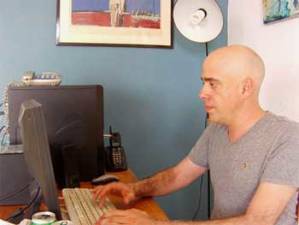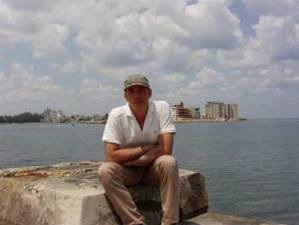Cuba’s First Crowd-Funding Platform
By Alfredo Fernandez

HAVANA TIMES – A graduate in Information Technology at Havana’s CUJAE university in 1992, Ubaldo Huerta went to Boston later that year to live and work in Silicon Valley, San Francisco, California during the dot-com boom era, and later moved to Barcelona where he now lives.
Always with his native Cuba in mind, he co-directs www.yagruma.org, a Web 2.0 space to fund art projects in Cuba which he has been running from early 2012 together with Hiram Centelles, co-founder of www.revolico.com, also based in Spain, and Raquel Carrera in Havana.
Talking about the Yagruma project with Ubaldo Huerta, it is clear that he is perfectly suited to operating in cyber space, which is why he didn’t take the Spanish success of his web page www.loquo.com sitting down but went on to co-found the first crowd-funding platform focused on Cuba in January 2012.
Projects registered on www.yagruma.org are funded by visitors to the site interested in what it has to offer whether it is a documentary, an exhibition, a video clip, a movie, a book, or a long list of projects that until now rarely came to fruition due to the perennial lack of funds at the Ministry of Culture, or the paranoia on the part of the authorities when it comes to anything created independently.
To find out more about www.yagruma.org, I met up with Ubaldo Huerta, one of its founders, on an afternoon early in May 2012.
HT: Ubaldo, what makes you think, in the middle of a global crisis, a group like Yagruma can find people interested in funding projects, especially in a country as controversial as ours where the public has very restricted access to the internet?
UH: Look, the challenge we had when we set up www.yagruma.org was to find funding for art projects in a country that, as you rightly put it, is to all extents and purposes disconnected from the Internet. But if you look at the success of www.revolico.com, then you realize that although it may be difficult to make a success of Internet projects in Cuba, it is not impossible.
Take my word for it but the Yagruma project has additional challenges; firstly because the system of joint financing or crowd-funding as it is called, is hardly relevant in Cuba’s case, and has been feasible only in a very few countries so far. Collective financing is a mechanism allowing independent artistic creations to be financed from the sum of small individual contributions rather than through the traditional mechanism of institutional patronage. In other words, it is a disruptive phenomenon.
Secondly in Cuba, internet culture is practically non-existent, certain codes are unknown, and it is very difficult and sometimes impossible to upload a video using the insufferably slow connections on the island.

The good news is that there is growing interest in everything that is happening in Cuba, not only by the Diaspora. In other words, many people are willing to get involved, to lend a hand, to encourage artistic creation in Cuba.
HT: Has www.yagruma.com been able to fund any projects in the few months since it was set up?
UH: So far it has funded six projects out of the thirty-odd that have been uploaded to the site, which is quite normal for a platform for collective financing. If we add the uniqueness of Yagruma, where patrons and artists do not share the island’s living space, as well as the difficulty creators have to control the promotion of their own projects on Twitter or Facebook, you could say we have got off to a good start.
HT: What is the minimum contribution you can make to a project on www.yagruma.org?
UH: You can contribute a minimum of 1 euro without any counter benefit. It is the artists who set the amounts depending on the individual contribution, so for example, an artist can set the minimum contribution for the privilege of including the sponsor’s name on the credits of a documentary at 10 euros, and 100 euros for an invitation to the launch and getting a copy of the film.
HT: What would you suggest to the artist who is trying to finance his or her project through www.yagruma.org ?
UH: The key is for an artist to include a short video (maximum 2 minutes) aimed at potential sponsors explaining the project in person and justifying the use of the funds. Moreover, in the embryonic state that Yagruma is in, you should focus on projects with modest financing needs, around 1,000 euros, say, to name a random figure, but of course it is the artistic creator who decides how much needs to be financed as well as the length of the financing period, which is usually 40 days.
HT: What guarantees of getting your money back do the Yagruma managers offer to someone who invested in a project that failed to meet its funding target?
UH: At the end of the funding period, two things can happen: if the financial objective is met, the maker receives the full amount in Cuba by bank transfer from the account of the Yagruma Association in Barcelona. Otherwise, the sponsors receive an automatic refund through PayPal. This ‘all or nothing’ financing model ensures that the creator gets the minimum funds to complete the project and fulfill the commitments made with the sponsors.
HT: Why are you creating this Internet project for Cuba, if access to Web 2.0 in the country is getting more and more restricted and there is no sign of things getting better in the future?
UH: Yagruma is caught between myopia and the failed policies of the Cuban and the U.S. governments towards the Internet in Cuba and its use. Cuba has yet to take the first step towards making the necessary investment and effort to make Internet accessible to everyone, even in schools, universities, which desperately need it.
It is inconceivable that this is not the major priority of a government that 50 years ago set the world an example by mobilizing the country’s entire youth and resources to teach reading and writing to a whole army of illiterates. Time is running out; every day without broadband makes the hole we are digging deeper and the next digital literacy campaign more expensive.
The U.S. government on the other hand applies absurd laws that hinder the use of Internet on the island. For example, PayPal (electronic payment) is inaccessible; Google doesn’t allow its excellent browser Google Chrome to be downloaded on the island, and also prevents it from being updated. Google App Engine (cloud platform for web sites), is the same. I have repeatedly called Google, and of course only get evasive answers; they say it’s their “interpretation of the embargo laws regarding the export of encryption technology (https, ssl).”
HT: Why did you choose the name of Yagruma?
UH: Yagruma is easily remembered by all Cubans, although the name is a bit difficult for Anglophones who would pronounce it something like “iagroma”. On the other hand, the yagruma (leaf) has two sides to it: the island and its Diaspora. Let’s hope the virtual yagruma grow as fast as the leaves on the yagruma tree.
HT: Ubaldo, thanks for talking to HT.
UH: Thank you for allowing me to promote Yagruma on HT, one of the spaces on Cuba that I have the most respect for.





